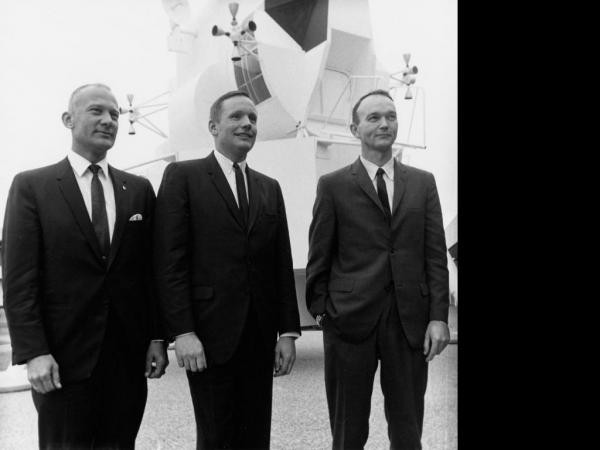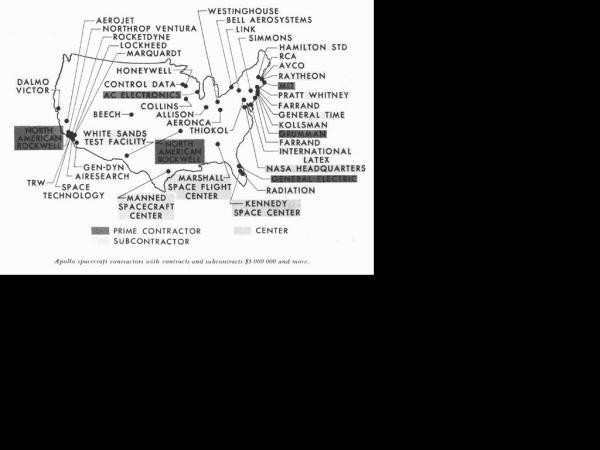Christina Ferwerda's collections
Destination Moon: The Mighty Saturn V
<p>The Saturn V is the most powerful rocket flown to date, but how did it actually work? this collection investigates the three stages of the Saturn V rocket, as well as the Instrument Unit. By making comparisons between the engines and computer located on the Saturn V and familiar technologies, students will gain a better understanding of the power and function of the mighty Saturn V. </p>
<p>This collection also uses and familiarizes students with several Earth and Space science terms. When exploring this collection, discuss and provide students with the following vocabulary list: </p>
<p>Thrust, stage, orbit, velocity, combustion, vacuum</p>
 Christina Ferwerda
Christina Ferwerda
9
Destination Moon: Suiting Up for Space
<p>How did the space suit come to look the way it does? From the United States Navy's Mark IV pressure suit to the Apollo AL7 model, this collection explores its evolution. Investigate the hotspots in each image, and watch the videos included. Try to put yourself in the place of an astronaut - what are their needs, and wants? </p>
<p>Next, investigate the roadmap for the developing Mars One mission. How will a Mars mission differ from the Mercury, Gemini, and Apollo programs?</p>
<p>After exploring the collection, see if you can redefine the "space suit" problem for the next generation of space explorers - specifically those going to Mars. Will astronauts need more mobility? More protection? What insights did you gain from looking at this collection? Write down the problem and any critical information gained. </p>
<p>Additional Activities: </p>
<p>1. Come up with as many solutions as you can to the defined problem. Don't worry about testing them all - let your imagination run wild - and challenge yourself to come up with lots of different solutions. </p>
<p>2. Talk with a partner to see which solution has the most merit between you both. Refine your idea based on this conversation. </p>
<p>Finally, prototype! Use simple, inexpensive materials to model your design. </p>
 Christina Ferwerda
Christina Ferwerda
7
Destination Moon: Origins of the Space Race
<p>This topical collection introduces events that shaped the origin of the Space Race; its connections to World War II, rocketry, nuclear development, and the Cold War. </p>
<p>After exploring the collection, students will have a better understanding of how the Space Race evolved from a specific group of geopolitical events. This collection introduces figures from American politics and outlines international events that pushed the United States to mobilize around the Mercury, Gemini and Apollo programs. </p>
<p>Students begin by watching the overview video. The resources that follow include metadata summaries, quiz questions, and hotspots to draw attention to details in each resource, and provide an overview of the complex geopolitical situation. This collection is best used as a primer to the space race and could be enhanced by further discussion. </p>
 Christina Ferwerda
Christina Ferwerda
14
Destination Moon Crew Guide: Apollo 11 Command Module Pilot Michael Collins
<p></p>
<p>This topical collection explores the life of Command Module Pilot Michael Collins; it includes images, artifact images, and websites. Through browsing this collection, students will learn about Collins' life, in order to appreciate how his work as a pilot and astronaut impacted his personal and private affairs.</p>
<p>This collection is inspired by the Unveiling Stories thinking strategy introduced by Harvard's Project Zero, which invites students to reveal multiple layers of meaning in stories: </p>
<ul><li>What is the story?</li><li>What is the human story?</li><li>What is the world story?</li><li>What is the new story?</li><li>What is the untold story?</li></ul><p>Have students look at each image, video or resource, and read its descriptions. Ask students to think about or respond to any quiz questions included. </p>
<p>Tags: moon, moon landing, Apollo 11, Apollo XI, Aldrin, space, space race, astronaut</p>
 Christina Ferwerda
Christina Ferwerda
8
Destination Moon Crew Guide: Apollo 11 Commander Neil Armstrong
<p>This topical collection explores the life of Mission Commander Neil A. Armstrong; it includes images, artifact images, video and websites. Through browsing this collection, students will learn influential aspects of Armstrong's life, in order to appreciate how his work as a pilot and astronaut impacted his personal and private affairs.<br /></p>
<p>This collection is inspired by the Unveiling Stories thinking strategy introduced by Harvard's Project Zero, which invites students to reveal multiple layers of meaning in stories: </p>
<ul><li>What is the story?</li><li>What is the human story?</li><li>What is the world story?</li><li>What is the new story?</li><li>What is the untold story?</li></ul><p>Have students look at each image, video or resource, and read its descriptions. Ask students to think about or respond to any quiz questions included.<br /></p>
<p>Tags: moon, moon landing, Apollo 11, Apollo XI, Armstrong, space, space race, astronaut</p>
<p><br /></p>
 Christina Ferwerda
Christina Ferwerda
11
Destination Moon: Apollo Around the Country
<p>This collection explores regional contractors that contributed to the Apollo Program. Union Carbide, North American Aviation, and RCA are just three of the many private firms that contributed goods and services to NASA during the race to put a man on the Moon. </p>
<p>Have students examine the map of NASA contractors. Ask: </p>
<ul><li>What companies do you know? </li><li>Which are closest? Farthest away?</li><li>What do you wonder about these companies? Their locations? </li></ul><p>Have students investigate the images in the collection. Discuss: </p>
<ul><li>What do you see? What do you think about that? </li><li>What types of products or materials were needed on the Apollo mission? </li><li>How did companies take advantage of their association with Manned Spaceflight? </li></ul><p>Using the map, encourage students to find items produced by other manufacturers on this database by searching the manufacturer name. Compare the products associated with different companies - what types of products do they see, and what types of products are missing? Are there advantages to having certain things produced closer to the launch site? What types of items could be produced farther away? </p>
<p>Invite students to find other Apollo-related advertisements from the period using the Internet. What can be said about these advertisements? </p>
<p>Invite students to create their own advertisement based on the items they find here, as well as research about the NASA-contracted company. </p>
 Christina Ferwerda
Christina Ferwerda
12






